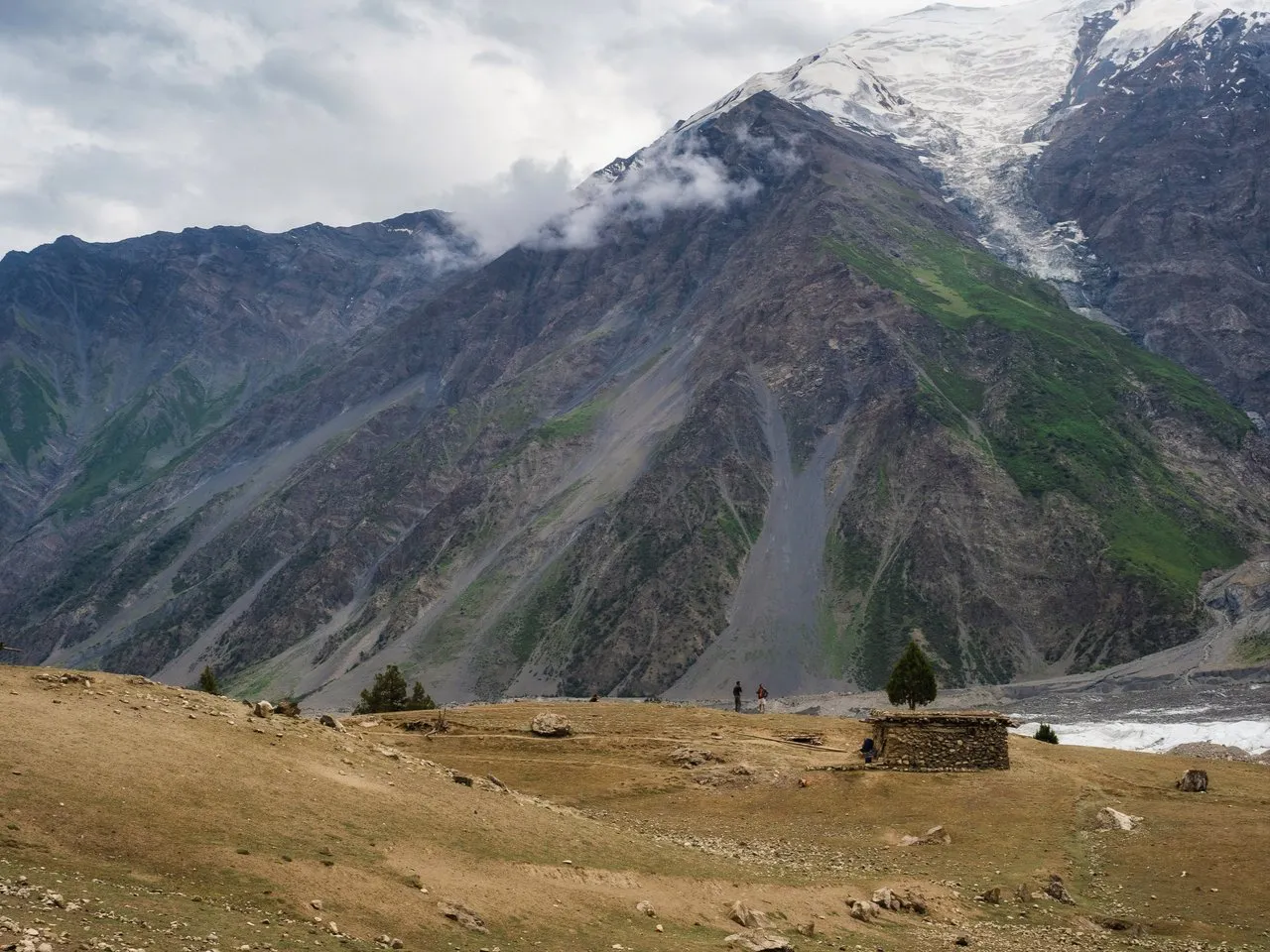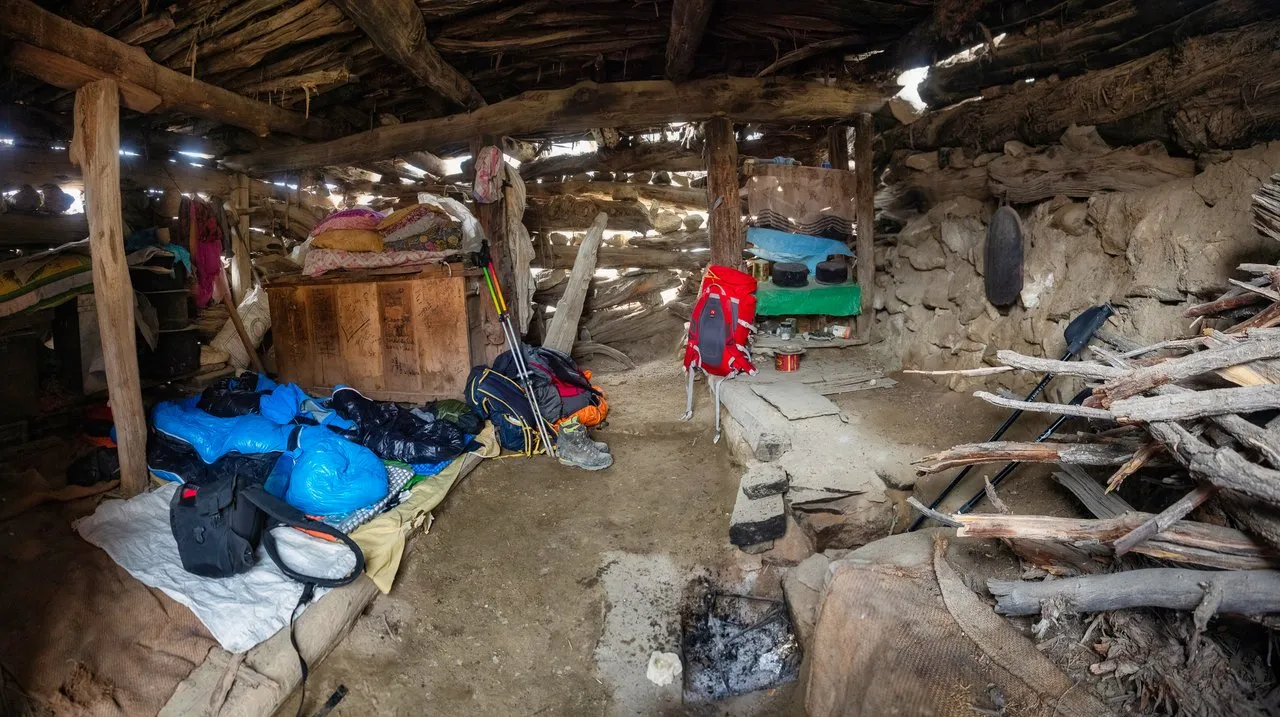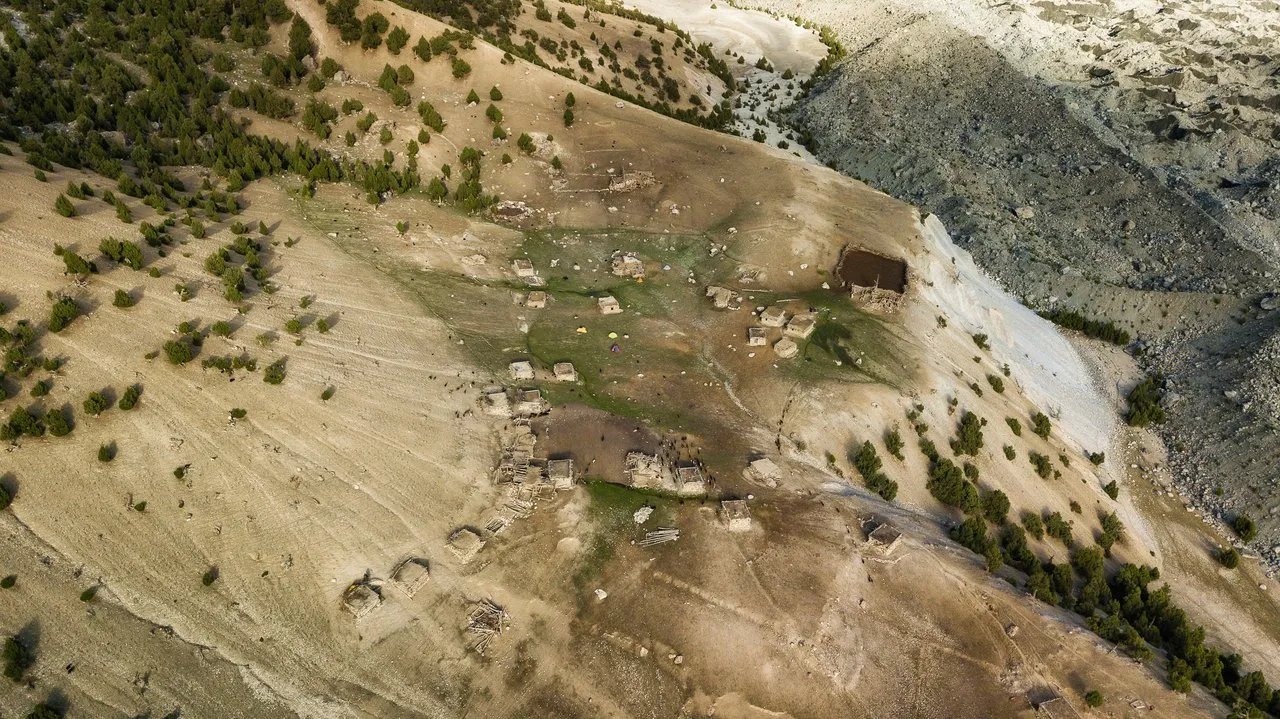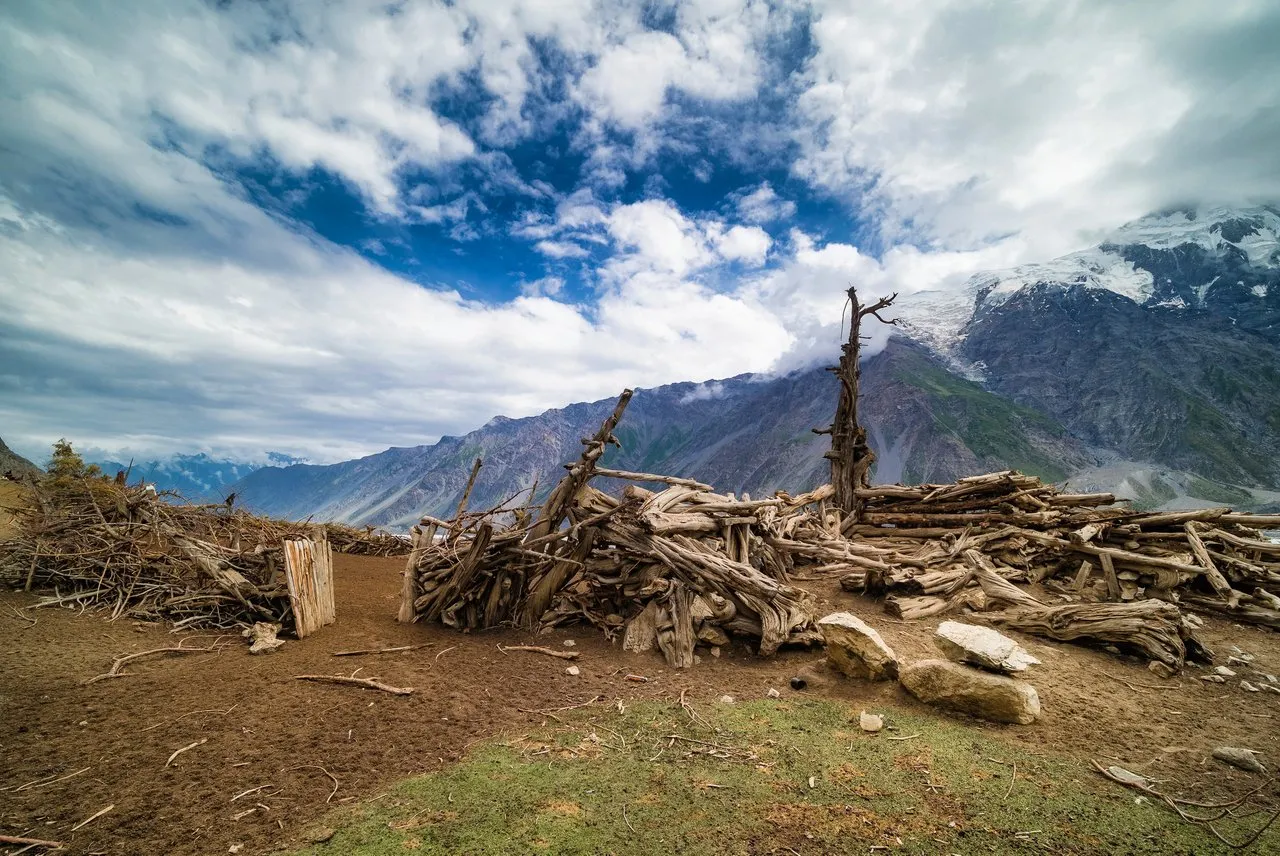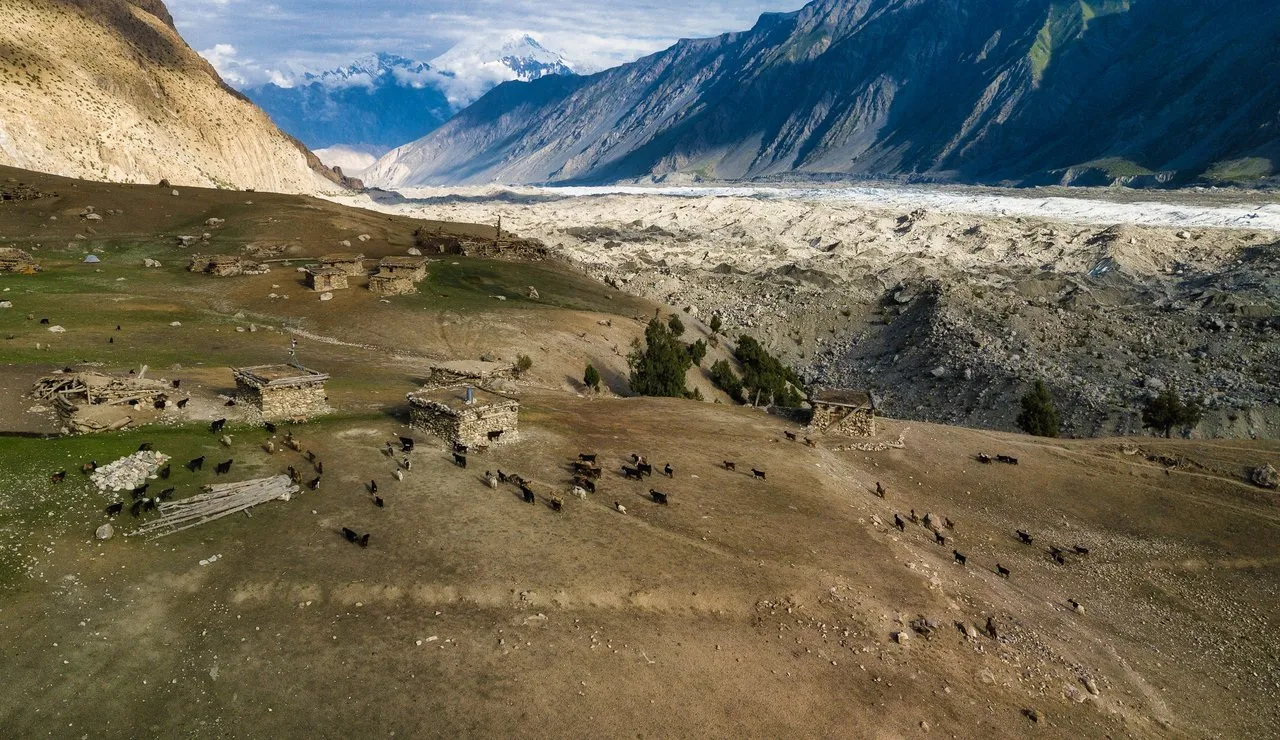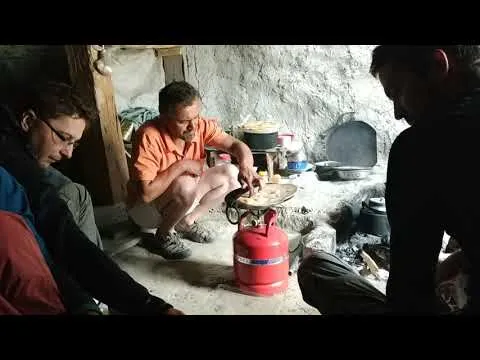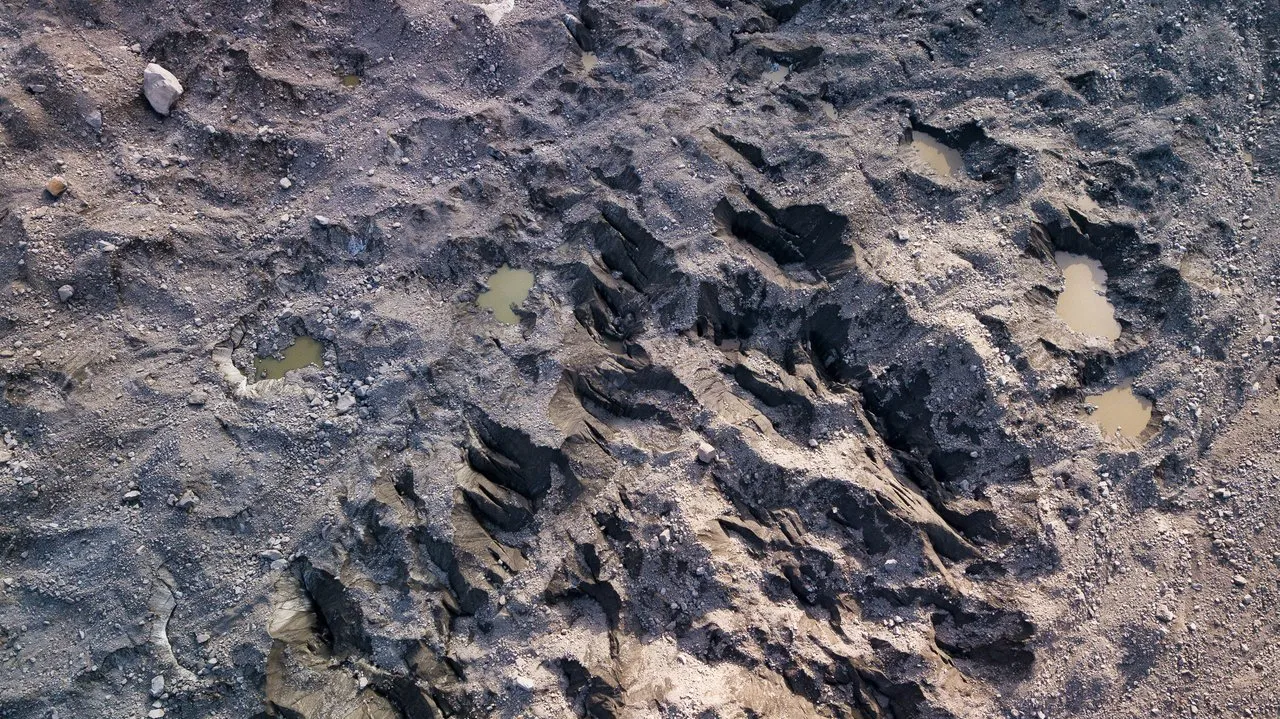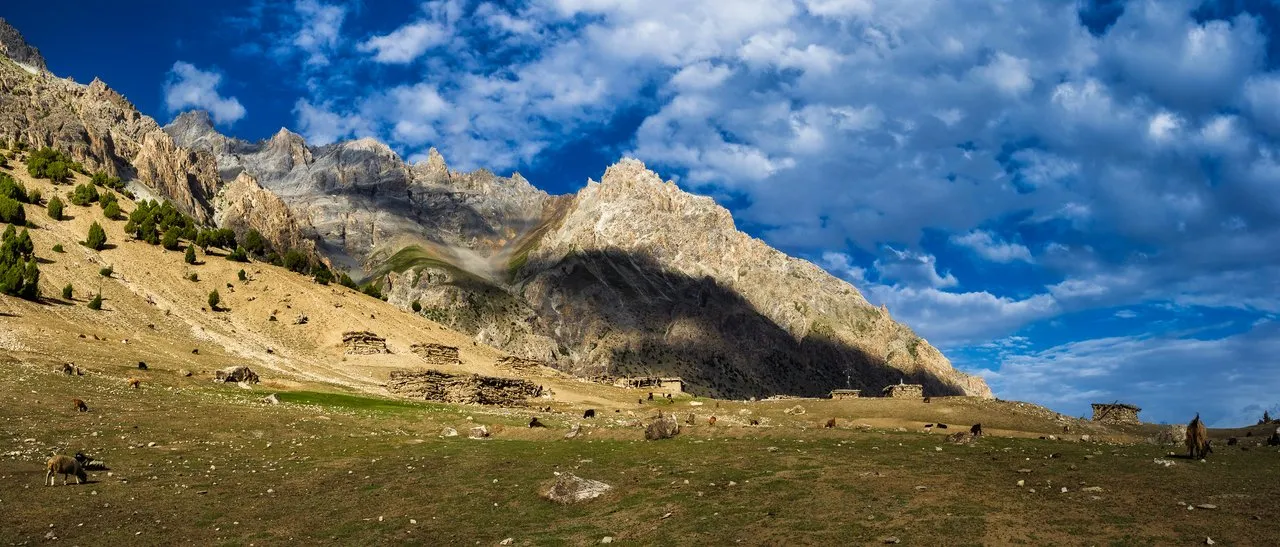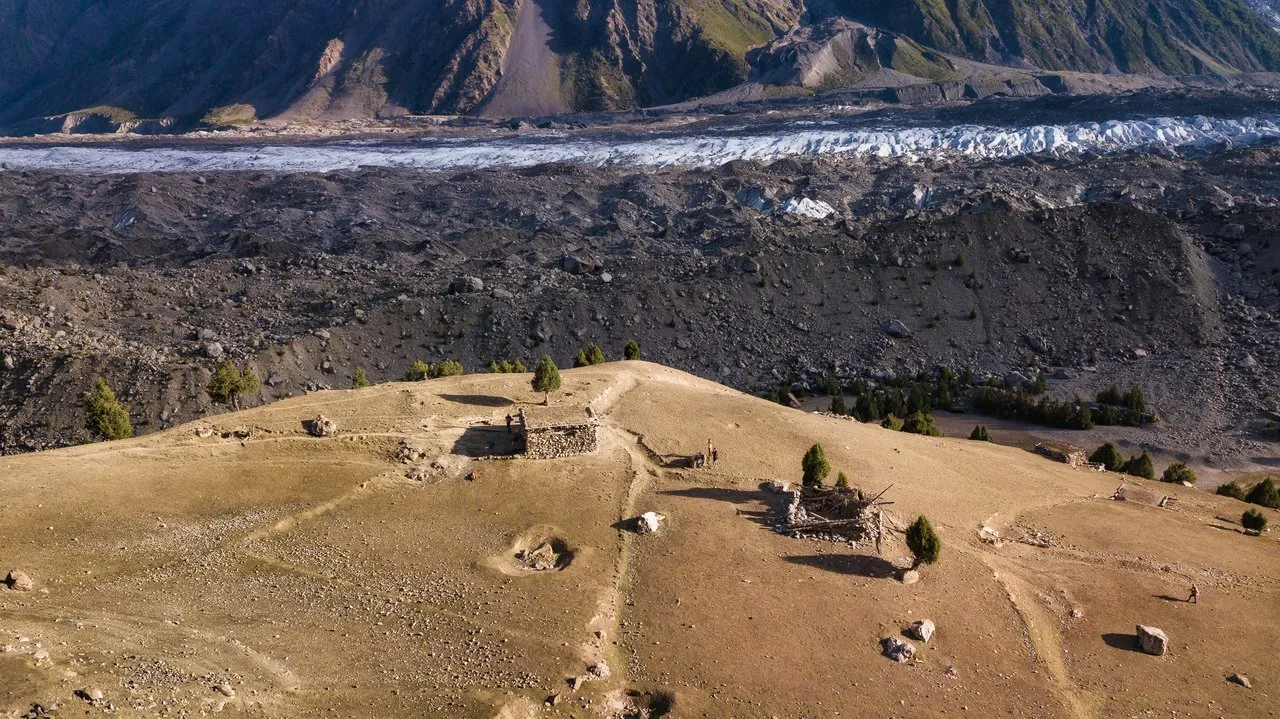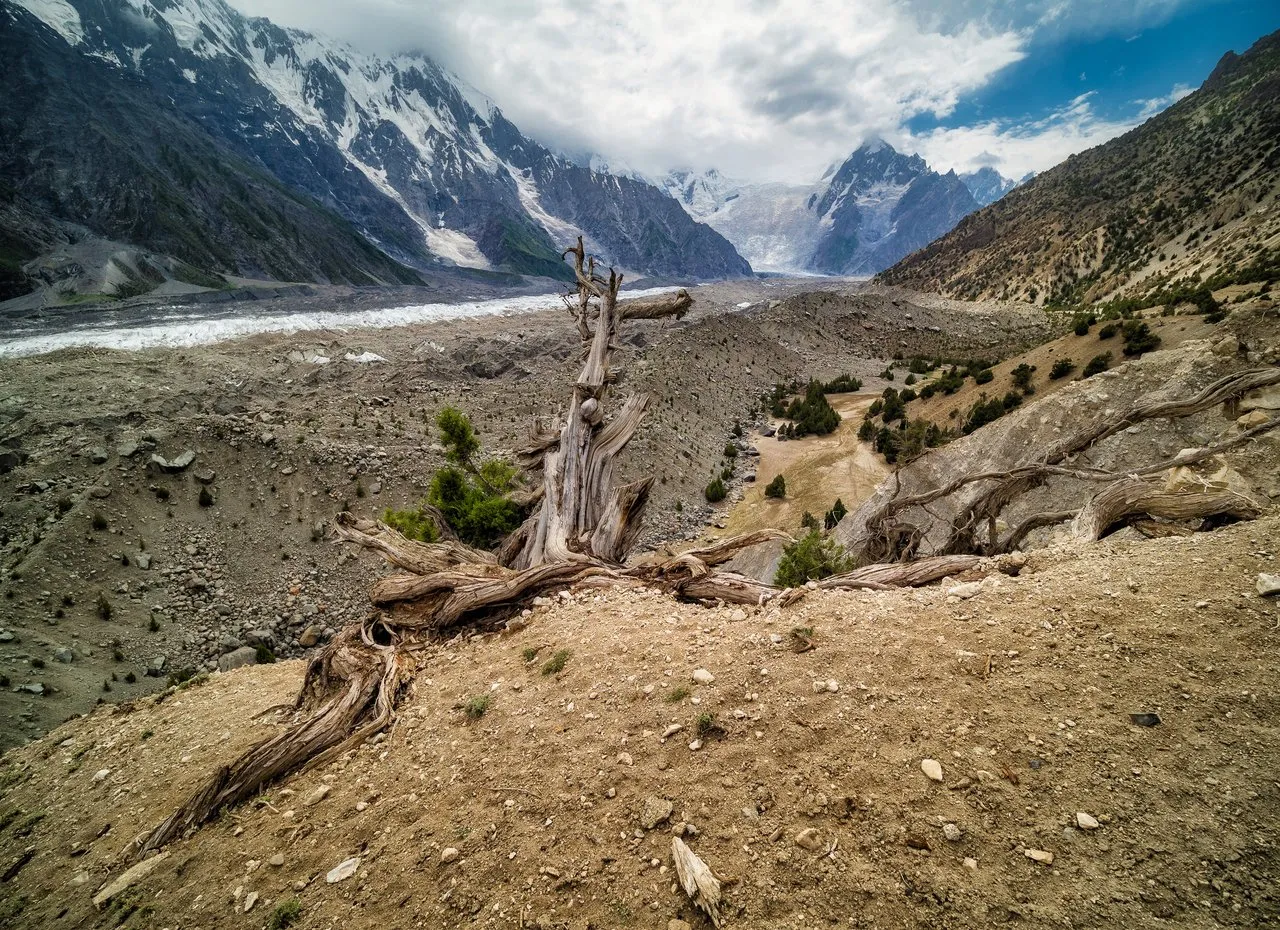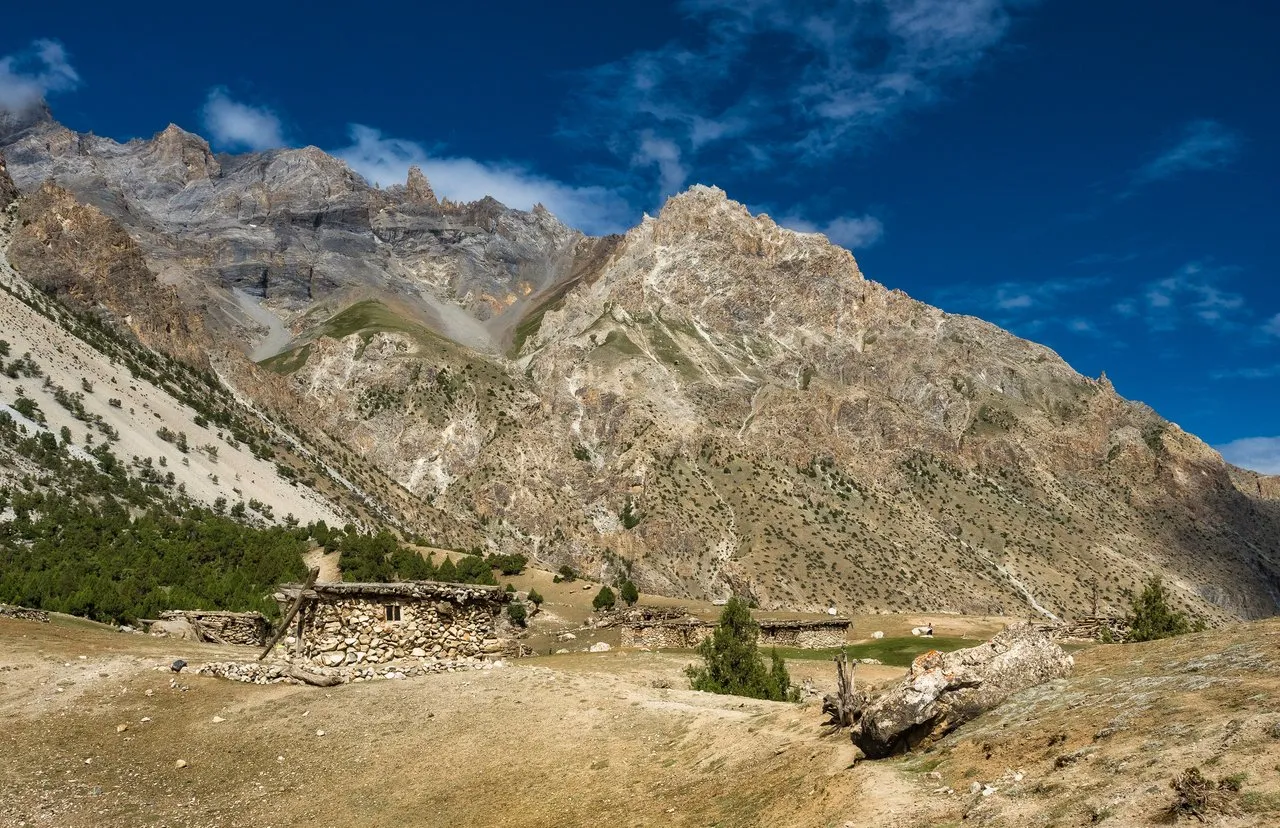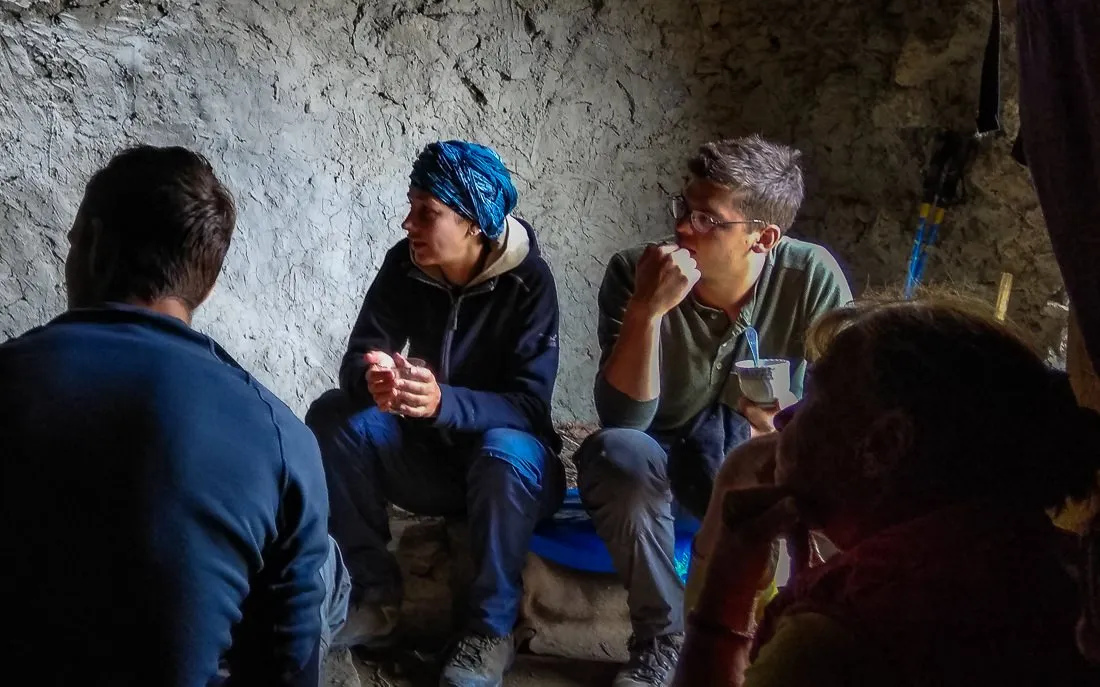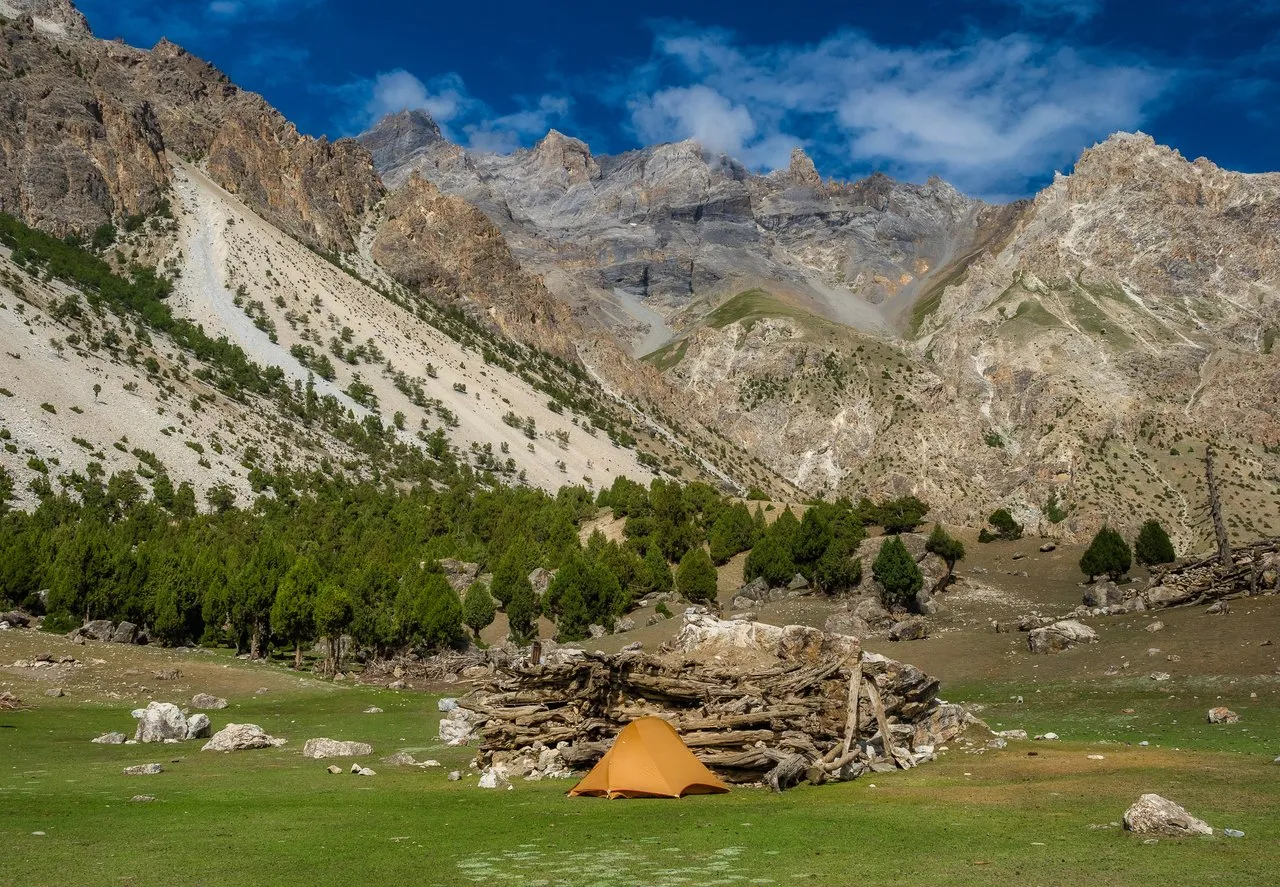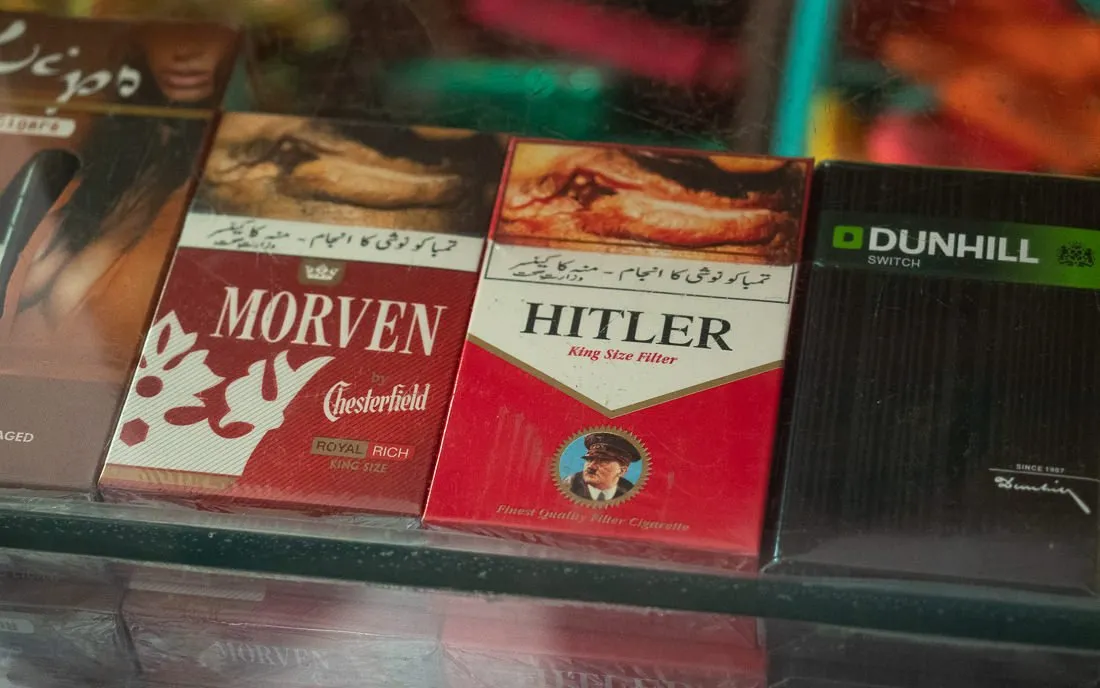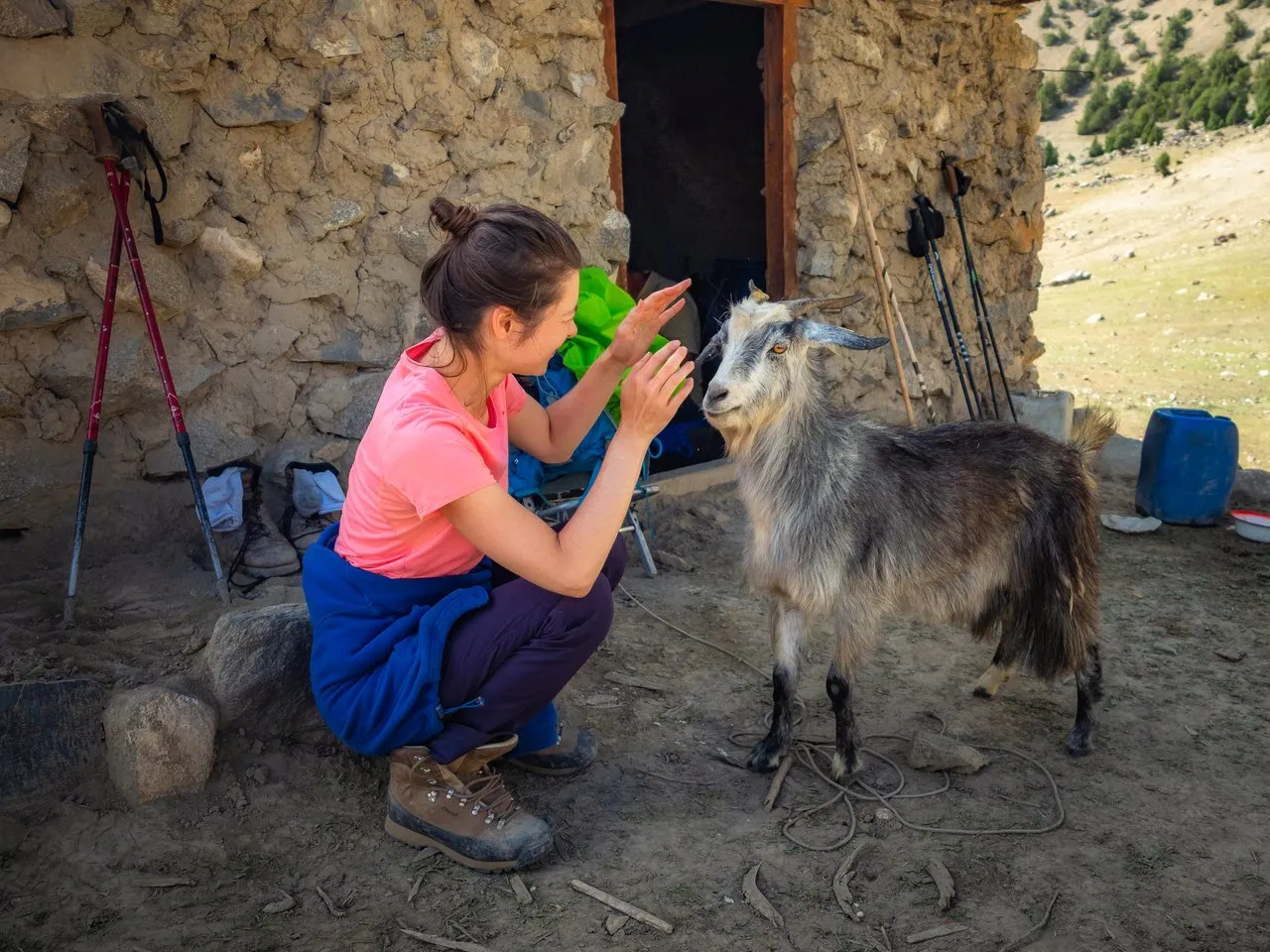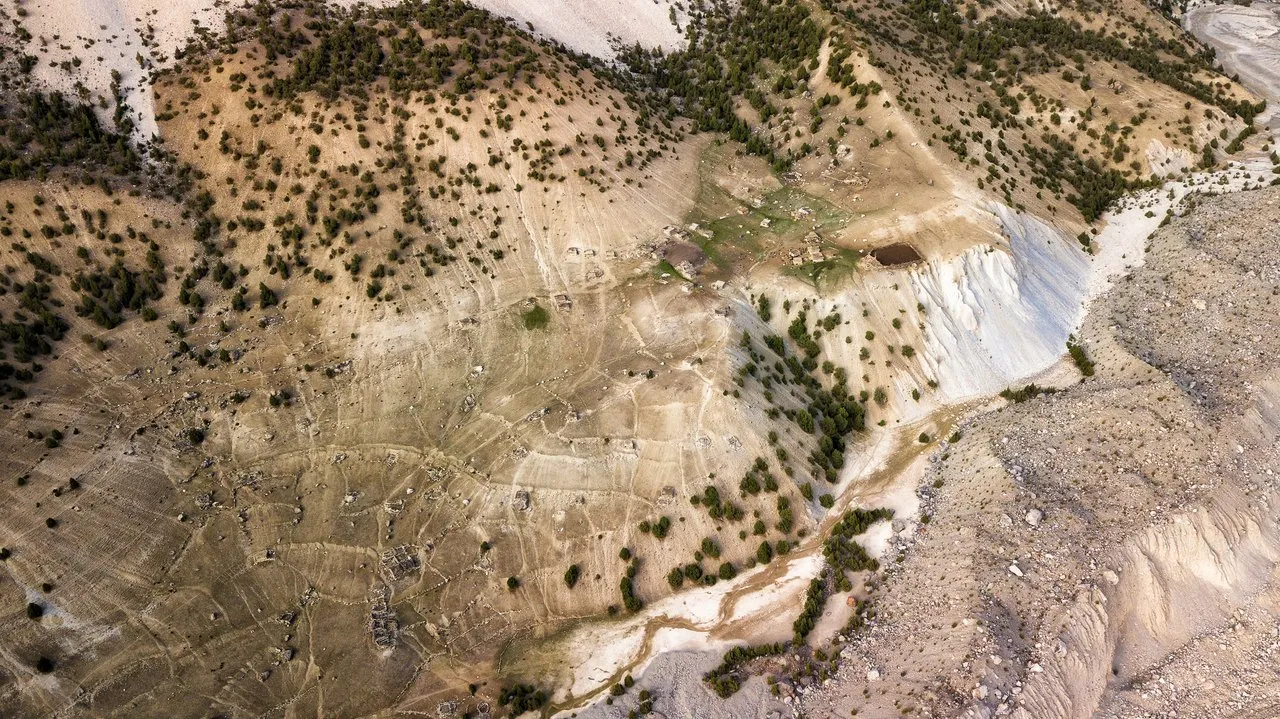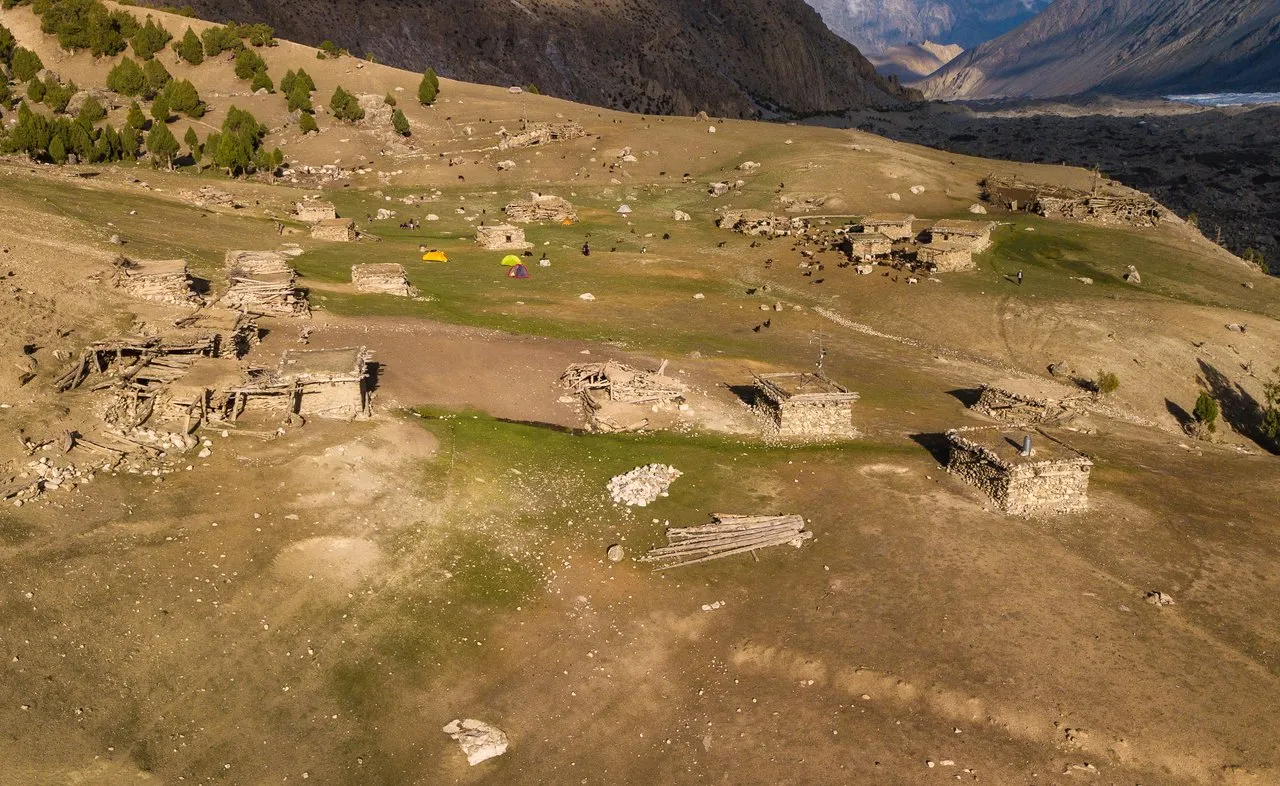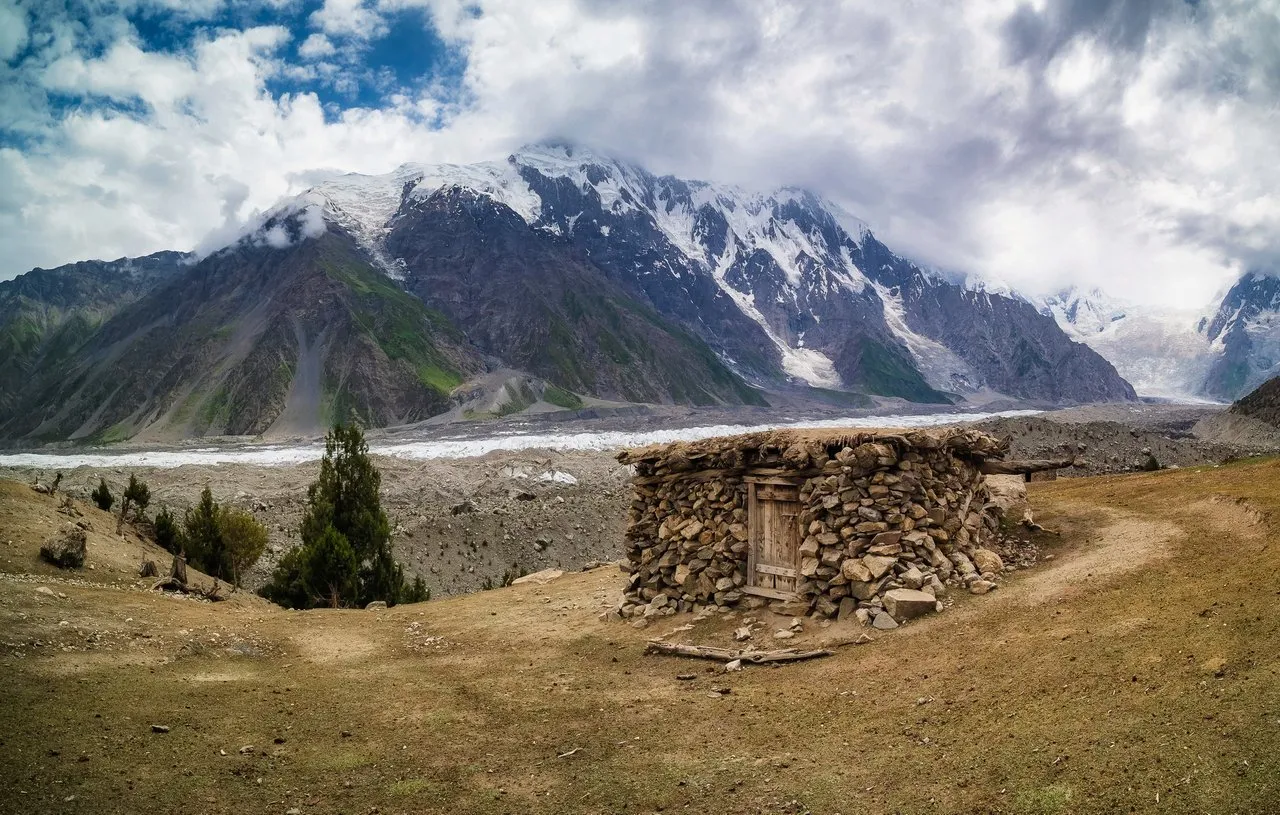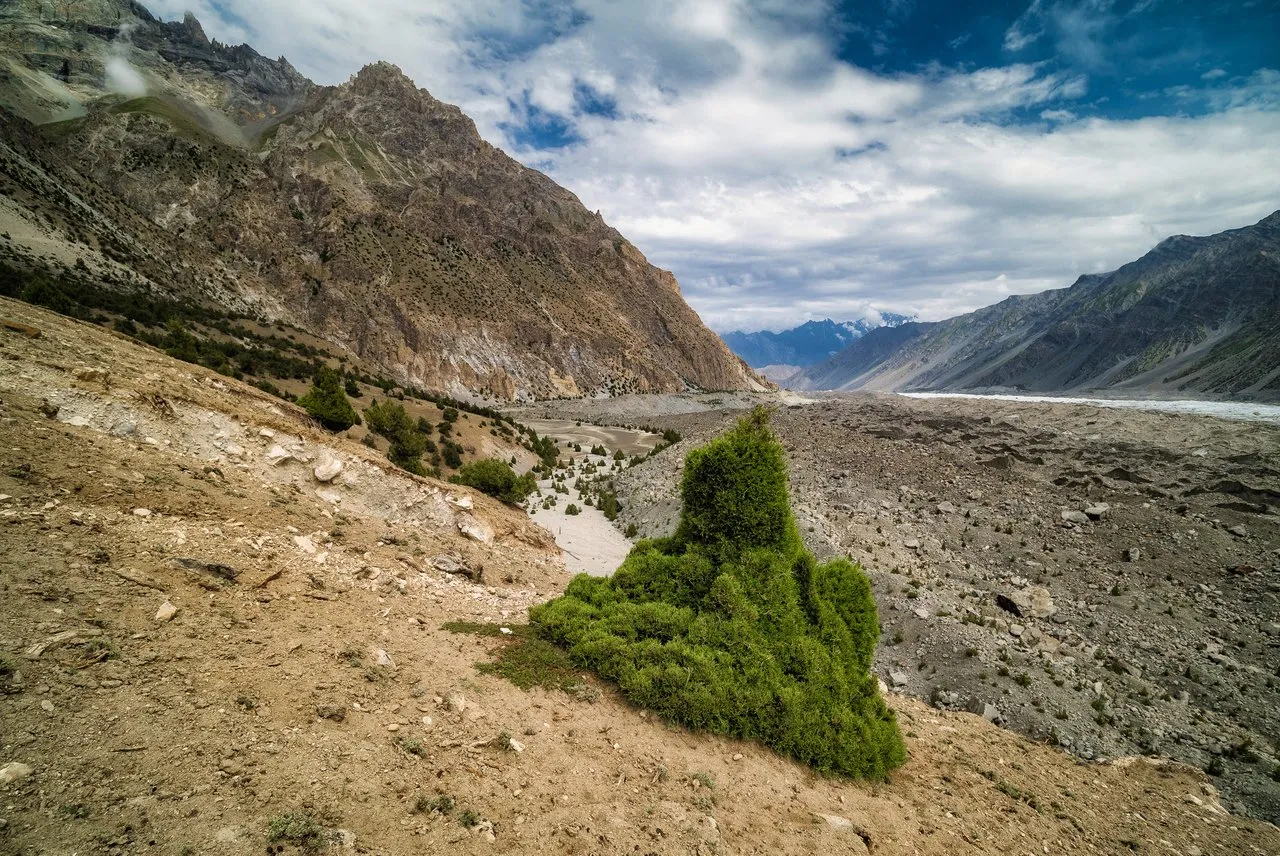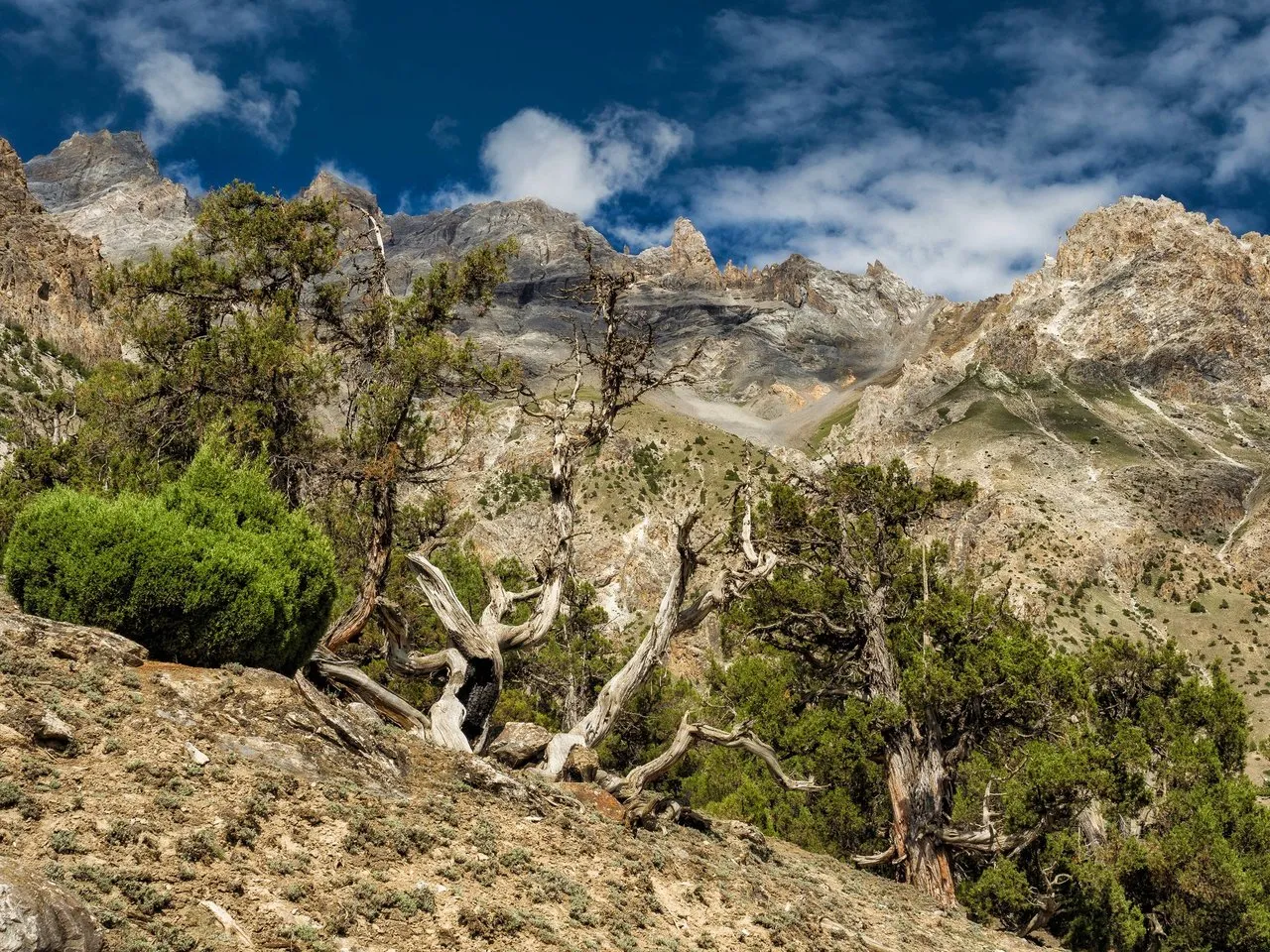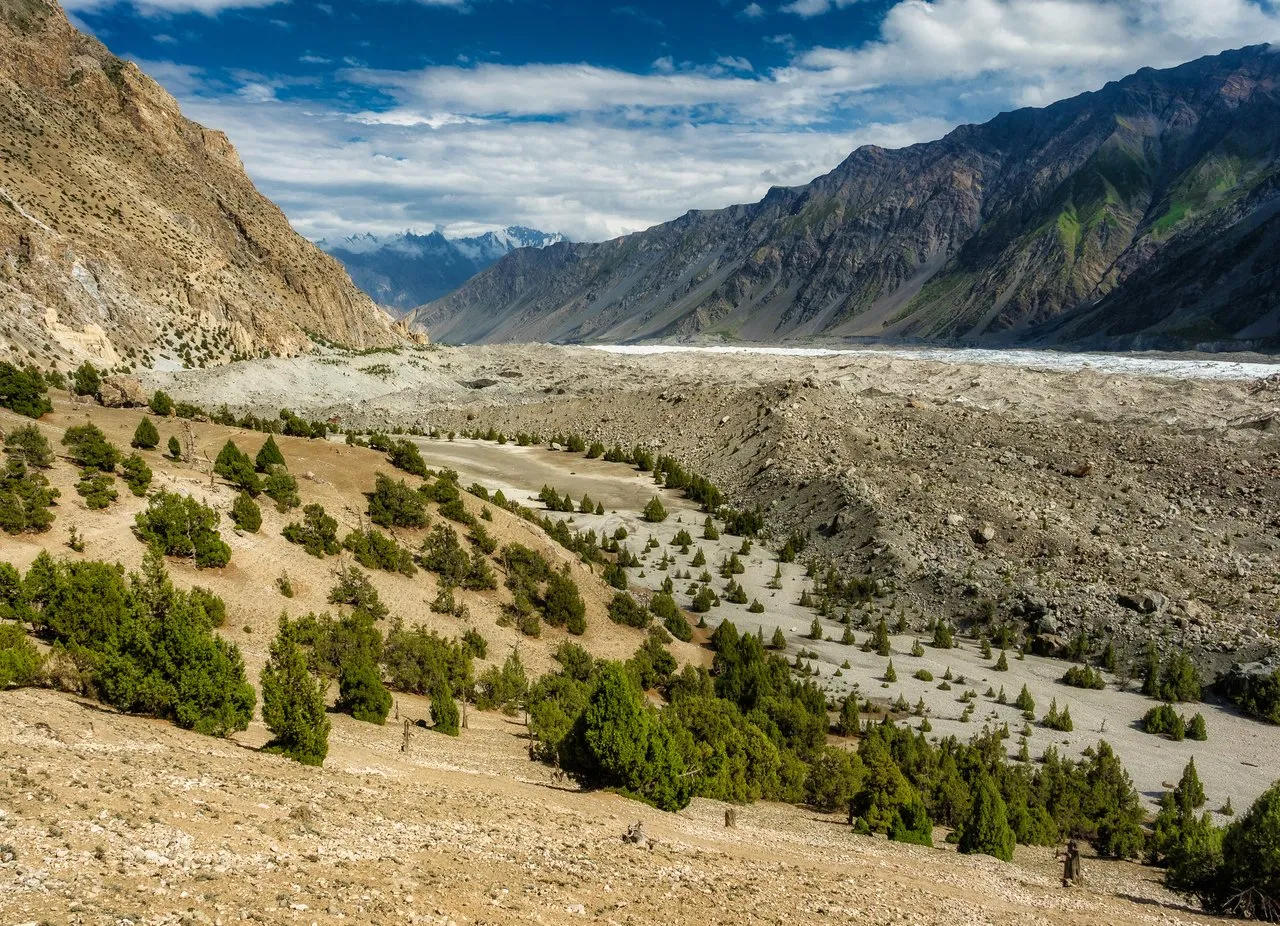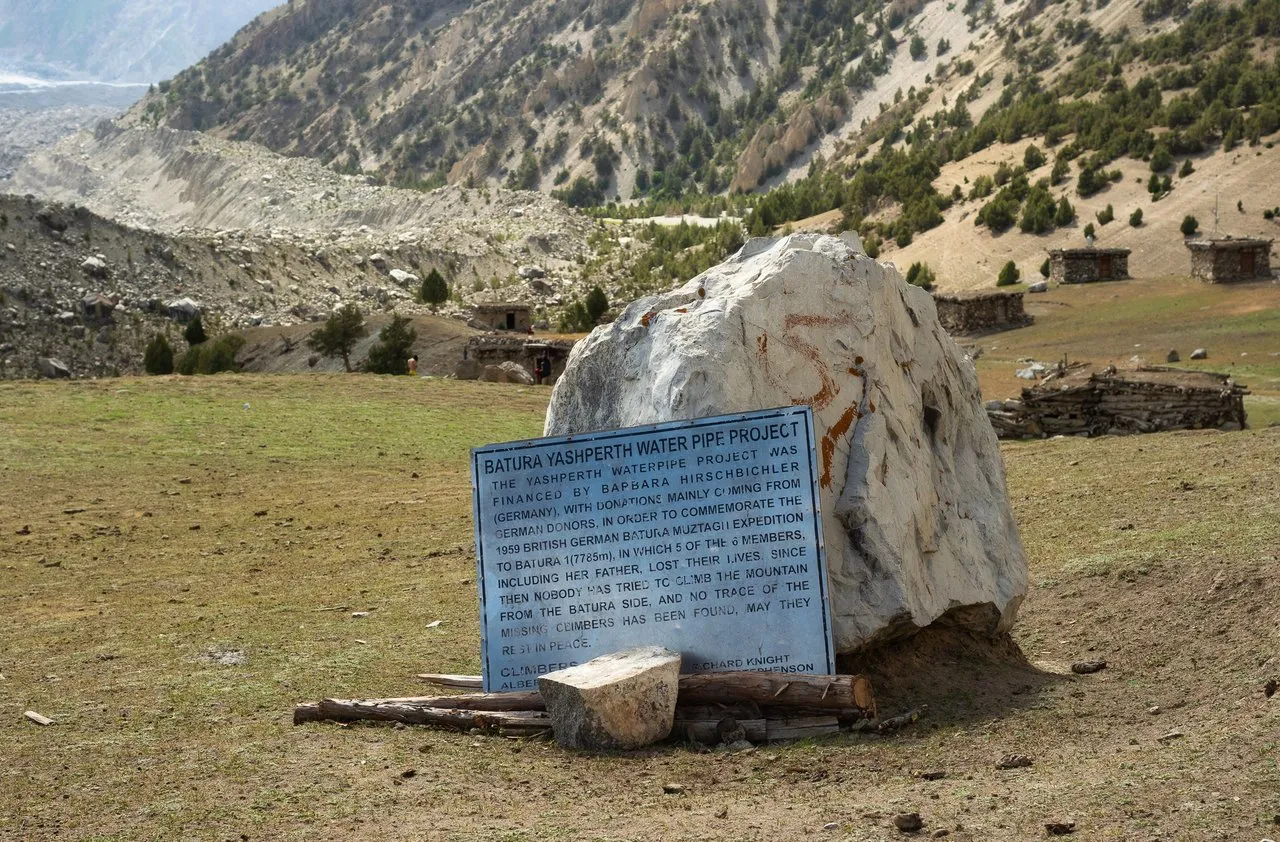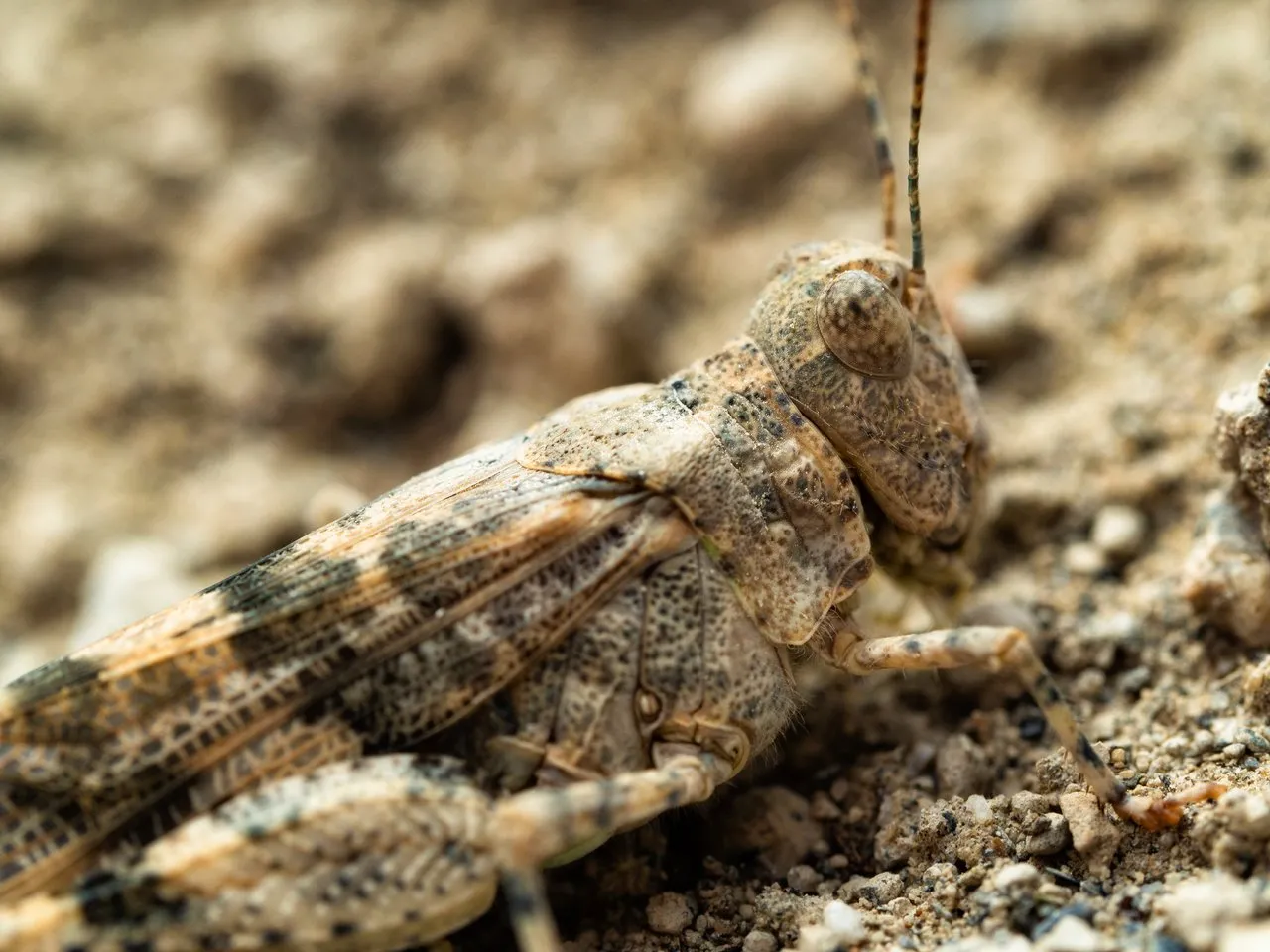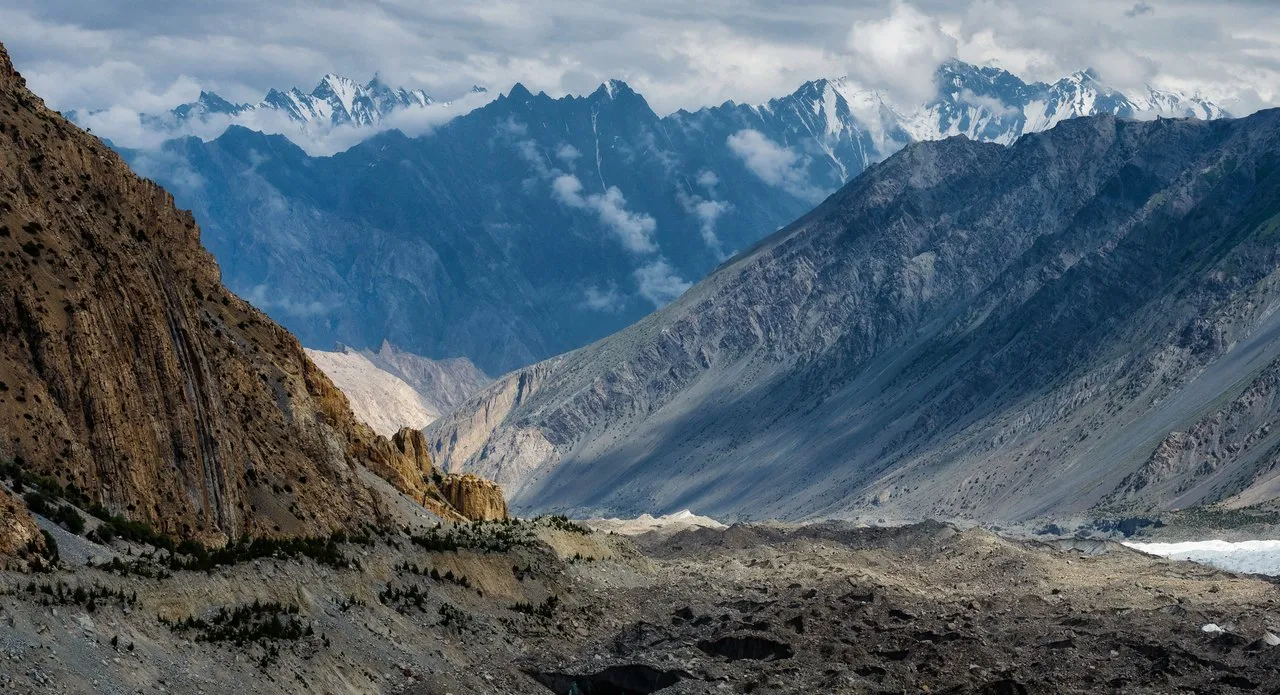All night after crossing the Batura glacier, I dreamed of a fantasy war between medieval kingdoms — knights, fluttering flags, battles and intrigues. Apparently, this is due to fatigue :) In the midst of events of the dream, an alarm clock woke me up at 4:30 am, informing me that it was time to get up and go to take pictures of the dawn.
Looking out the door, I realized that I could continue sleeping: the sky was covered with clouds and it was raining — no beautiful sunrises were promised. I went back to check my dreams, chase the annoying mosquito and rid the hut where we slept from the black beetles swarming in the dust near the sleeping bags.
At ten in the morning Dima knocked on the door and said that breakfast would be ready soon. Yes, it was worth going so far to finally get some sleep! The closest house in the photo is our "hotel" for the coming nights in the shepherd's village of Yashpert.
View inside of the hut. Our things add color to the interior. Light is added to it by holes and crevices in the walls — not all of them are made using mortar that holds stones and wood together, some are simply folded somehow.
This is how the village looks from above. The large brown square is a corral for goats and sheep.
And this is what the corral looks like closer. The gates are open and the animals are walking around.
Well, let them walk, there is a shepherd's village here, so that they graze here in the vicinity.
After washing in the brook, we went to our local guide Bayram's hut, where he was already frying chapatis in a flat frying pan. He kneads the dough with water, makes a thin cake, puts it in a pan, pours oil on top and turns it over. As the bubbles went — flips back. The process can be clearly seen in the video filmed by @kibela on the phone:
Then he made black tea with ginger, which Elena brought, and at the end poured goat's milk into a saucepan. We ate chapatis with orange jam and honey, washed them down with tea, and Bayram began to talk about the history of these places.
To the south of the Batura glacier, near the Karokoram highway in Karimabad, is the Baltit fort (I've shown it here). Previously, the eponymous capital of the Hunza principality was located there, where in 1888 an expedition of the Russian military geographer and orientalist, Captain Bronislav Grombchevsky arrived.
The ruler of Hunza Safdar-Ali met him and even asked for citizenship to the Russian tsar, but the British could not allow this, and the "Anglo-Brusho War" began (in the Russian and English Wikipedia it is written about it differently, but I retell Bayram's story)
The Hunza was occupied, and this territory remained under British rule until 1947, when it gained independence and was divided between India and Pakistan. The Hunza principality ceased to be a principality and became simply the Hunza-Nagar district — part of the Gilgit-Baltistan administrative unit.
Today, Hunza is run by the Pakistani Ministry for Kashmir and Northern Territories, but the region receives nothing from the Pakistani government (according to Bayram's words).
Roads in the region are built by China, education and hospitals are provided by the Aga Khan, since Ismailism (in particular, Nizari Isma'ilism) is very developed in this region, and the locals do not want to be at enmity with India either. They do not pay any taxes: "Why would I pay this garbage government if everything here is mine — water, electricity, which generates a generator, and land?"
By the way, there were quite a few legends about the Hunza region, saying that "people here do not know diseases and live long, because they eat right and do not eat meat." In Russian versions, these texts have almost the same content and set of photographs.
The traveler Sergei Boyko, whose photographs were used in such articles, decided to tell how things really are and where these legends came from in two articles: "Hunza - the country of long-lived vegetarians" and "Many years to the inhabitants of Hunza" (both are in Russian language).
Once, two Indian tourists arrived at the hotel in Islamabad, where Bayram worked. His manager didn’t rent them a room because he said he had instructions with a ban. Bayram said it was wrong and checked them into a hotel. Two days later, on a tip from one of the workers, the police came to him: "You must not rent them a room!" To which Bayram replied: "You gave them permission to enter the country, so they have the right to live here!" He was promised problems, so he officially evicted them but settled them unofficially on the roof, and they lived there safely for 8 days.
Now there are very few tourists, Pakistanis associate the recession with the events of September 11, after which the already poor flow of tourists has completely dried up. However, by now the situation is already beginning to slowly improve.
His stories were interrupted by a greeting: "Hello!" Three young Germans who first met in Islamabad came to meet us. For two days they could not cross the glacier and returned to the camp, as they could not find the path. They went on their own because their tourist guide said that a guide was not required here. As a result, they saw our porters and followed them. Bayram says: "Welcome to my VIP Hotel!" :)
He said that a month ago he crossed this glacier with a large load, and this trip was very easy, but over the past time the glacier has changed a lot, and this time the path turned out to be much more difficult.
Before meeting her fellow countrymen, a German girl, Yulia, had been traveling in Pakistan alone for a month already, with a turban wound on her head. She is a teacher of Spanish, English and French. She even understands Russian, but does not speak it very well.
We recently saw that the Taliban have cigarettes with the image of Hitler. Suddenly! And the German guys were just fed up with constant questions about him. They say that this is not a joke for them at all and they really do not like it all.
Well, we sat in Bayram's hut enough, it's time to get out. We leave — and see Dina trying to get in touch with the local goats. They are beautiful, as I have said more than once. Later, I'll post more of their portraits separately :))
After all the stories, we went for a walk around the neighborhood, to see what was around us.
Look from a height, and walk with our legs to stretch them slightly after yesterday's trek.
A little below the main group of inhabited houses of the village we saw a few more, but in a dilapidated state. I wonder why this is so?
Oh, and in one hut there is even a pipe from the stove sticking out!
In general, of course, it's a very picturesque place. I can imagine what it is like here in winter — everything is probably covered with an endless blanket of the whitest snow! But, probably, they don't live here in winter, and go closer to civilization.
In these places wonderful trees grow: it seems that they have stands at the base.
It's a pity, but I did not learn their name from the locals. So now I don’t know what kind of trees they are and whether they always have this kind :)
There are also a lot of picturesque snags here — the dried up tree skeletons stand firmly.
In 1959, there was a British-German mountaineering expedition, five of the six members of which died while trying to climb the top of Batura Sar from the glacier. It is unknown if they reached the top and where their bodies are now.
The daughter of one of the climbers, Barbara Hirschbichler, who is also actively involved in mountaineering, when visited here in search of her father, asked the locals how she could help. They asked for the plumbing, and Barbara and other sponsors financed the project. And now here on the hill, right next to our hut, clean drinking water is constantly flowing from the pipe.
Local goats also clearly value useful infrastructure.
Local insects have adapted remarkably to the color of the soil. Look, even the eyes are spotty to match the earth!
Perfect coloration, I would not have noticed him if he did not move, and so — accidentally caught the movement on the ground. Pretty boy? :)
View towards where we came from. How beautiful! I wonder how it will be here at sunset?
To be continued...
Parts of the journey:
- The Land of High Mountains: Pakistan. Day 1. Arrival and Transfer to the Mountains
- The Land of High Mountains: Pakistan. Day 1. Trekking to Fairy Meadows
- The Land of High Mountains: Pakistan. Day 2. Acclimatization
- The Land of High Mountains: Pakistan. Day 3. Trekking to Nanga Parbat Base Camp - Start
- The Land of High Mountains: Pakistan. Day 3. Trekking to Nanga Parbat Base Camp - Finish
- The Land of High Mountains: Pakistan. Day 4. From the Himalayas to the Karakoram
- The Land of High Mountains: Pakistan. Day 5. The road to Mount Rakaposhi - Hakapun or further?
- The Land of High Mountains: Pakistan. Day 5. The road to Mount Rakaposhi - Base Camp
- The Land of High Mountains: Pakistan. Day 6. Minapin Glacier and Ice Bridge
- The Land of High Mountains: Pakistan. Day 7. How to Get to the Eagle's Nest?
- The Land of High Mountains: Pakistan. Day 8. Hike to Ladyfinger Peak
- The Land of High Mountains: Pakistan. Day 8. Walk in Karimabad to Altit and Baltit Forts
- The Land of High Mountains: Pakistan. Day 9. Karimabad and the Sacred Rocks of Hunza
- The Land of High Mountains: Pakistan. Day 9. Attabad Lake, Hussaini Bridge and Passu Cathedral
- The Land of High Mountains: Pakistan. Day 10. Crossing the Batura Glacier: the Beginning
- The Land of High Mountains: Pakistan. Day 10. Crossing the Batura Glacier: Finish
- The Land of High Mountains: Pakistan. Day 11. Shepherd's Village of Yashpert and Bayram Stories
- The Land of High Mountains: Pakistan. Day 11. The Vicinity of the Yashpert Village. Hidden Meadow
Camera: OLYMPUS E-M1 Mark II and DJI Mavic 2 Pro
It's better to watch the photos in high resolution — just click on them and open in a new window.
You can also see my photos in my blog LJ and in my profile on NatGeo



